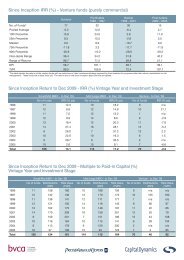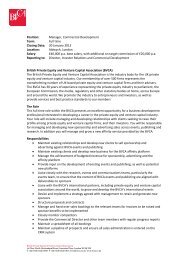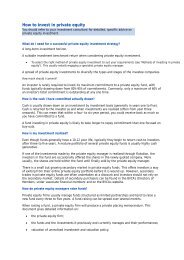A Guide to Private Equity - BVCA admin
A Guide to Private Equity - BVCA admin
A Guide to Private Equity - BVCA admin
You also want an ePaper? Increase the reach of your titles
YUMPU automatically turns print PDFs into web optimized ePapers that Google loves.
ut it requires a significant investment. An inves<strong>to</strong>r will look <strong>to</strong> your expertise as a salesperson, or <strong>to</strong><br />
the plans <strong>to</strong> hire, train and compensate an expert salesforce. If more than one distribution channel<br />
is used, they should all be compatible. For example, using both direct sales and wholesalers can<br />
create channel conflict if not managed well.<br />
Fully explain the reasons for selecting these distribution approaches and the financial benefits they will<br />
provide. The explanation should include a schedule of projected prices, with appropriate discounts<br />
and commissions as part of the projected sales estimates. These estimates of profit margin and<br />
pricing policy will provide support for the investment decision.<br />
Promotion<br />
The marketing promotion section of the business plan should include plans for product sheets,<br />
potential advertising plans, internet strategy, trade show schedules, and any other promotional<br />
materials. The private equity firm must be convinced that the company has the expertise <strong>to</strong> move<br />
the product <strong>to</strong> market. A well-thought-out promotional approach will help <strong>to</strong> set your business plan<br />
apart from your competi<strong>to</strong>rs.<br />
It is important <strong>to</strong> explain the thought process behind the selected sources of promotion and the<br />
reasons for those not selected.<br />
Competition<br />
A discussion of the competition is an essential part of the business plan. Every product or service<br />
has competition; even if your company is first-<strong>to</strong>-market, you must explain how the market’s need is<br />
currently being met and how the new product will compete against the existing solution. The inves<strong>to</strong>r<br />
will be looking <strong>to</strong> see how and why your company can beat the competition. The business plan<br />
should analyse the competition (who are they, how many are there, what proportion of the market<br />
do they account for?). Give their strengths and weaknesses relative <strong>to</strong> your product.<br />
Attempt <strong>to</strong> anticipate likely competitive responses <strong>to</strong> your product. Include, if possible, a direct<br />
product comparison based on price, quality, warranties, product updates, features, distribution<br />
strategies, and other means of comparison. Document the sources used in this analysis.<br />
All the aspects included in the market section of your business plan must be rigorously supported by<br />
as much verifiable evidence as possible. In addition <strong>to</strong> carrying out market research and discussions<br />
with your management team, cus<strong>to</strong>mers and potential cus<strong>to</strong>mers, you may need input from outside<br />
marketing consultants.<br />
2. The product or service<br />
Explain the company’s product or service in plain English. If the product or service is technically<br />
orientated this is essential, as it has <strong>to</strong> be readily unders<strong>to</strong>od by non-specialists.<br />
Emphasise the product or service’s competitive edge or USP. For example, is it:<br />
• A new product?<br />
• Available at a lower price?<br />
• Of higher quality?<br />
• Of greater durability?<br />
• Faster <strong>to</strong> operate?<br />
• Smaller in size?<br />
• Easier <strong>to</strong> maintain?<br />
• Offering additional support products or services?<br />
With technology companies where the product or service is new, there has <strong>to</strong> be a clear “world class”<br />
opportunity <strong>to</strong> balance the higher risks involved. Address whether it is vulnerable <strong>to</strong> technological<br />
advances made elsewhere.<br />
The business plan<br />
A <strong>Guide</strong> <strong>to</strong> <strong>Private</strong> <strong>Equity</strong> 21
















